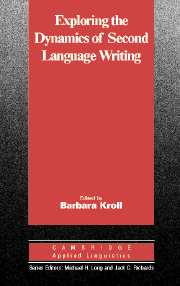Book contents
- Frontmatter
- Contents
- List of contributors
- Acknowledgments
- List of abbreviations used
- Series editors' preface
- Introduction: Teaching the next generation of second language writers
- I EXPLORING THE FIELD OF SECOND LANGUAGE WRITING
- II EXPLORING THE VOICES OF KEY STAKEHOLDERS:TEACHERS AND STUDENTS
- III EXPLORING WRITERS' FINISHED TEXTS
- IV EXPLORING CONTEXTUALITIES OF TEXTS
- V EXPLORING TECHNOLOGY
- EPILOGUE: EXPLORING OURSELVES
- Index
III - EXPLORING WRITERS' FINISHED TEXTS
Published online by Cambridge University Press: 05 October 2012
- Frontmatter
- Contents
- List of contributors
- Acknowledgments
- List of abbreviations used
- Series editors' preface
- Introduction: Teaching the next generation of second language writers
- I EXPLORING THE FIELD OF SECOND LANGUAGE WRITING
- II EXPLORING THE VOICES OF KEY STAKEHOLDERS:TEACHERS AND STUDENTS
- III EXPLORING WRITERS' FINISHED TEXTS
- IV EXPLORING CONTEXTUALITIES OF TEXTS
- V EXPLORING TECHNOLOGY
- EPILOGUE: EXPLORING OURSELVES
- Index
Summary
It is perhaps axiomatic to say that one learns to write by writing. And while no one disputes that many second language (L2) writers will grow into better writers simply by producing sufficient quantities of writing over an extended period (during which time their general language skills presumably improve as well), both native and second language writers often benefit most and make the most progress when teachers and peers contribute to this goal through a variety of intervention strategies available in classroom settings.
As long as they have been in existence, writing classes have tended to revolve around assignments that require students to produce various types of texts. What has changed in more recent methodologies in writing classes is the opportunity students are given to craft their writing – rather than being forced into a situation where all writing tasks are undertaken in a one-shot approach. Even in the era of so-called post-process approaches (Babin & Harrison, 1999, p. 223; McComiskey, 2000), most classes allow students to approach writing tasks through a series of stages in some kind of process framework. Regardless of other distinctions in their approaches to curriculum design and syllabus planning, many writing teachers would probably agree that extended work on a single piece of writing contributes most to students' ability to expand their writing skills.
Previous sections in this volume have examined issues in second language writing as a field of study, have given some insight into the way teachers conceptualize courses, and have shown how second language writers view their own learning.
- Type
- Chapter
- Information
- Exploring the Dynamics of Second Language Writing , pp. 115 - 118Publisher: Cambridge University PressPrint publication year: 2003

